Table of Contents
-
Use media databases like MuckRack to start, but always verify journalist info for current role and topic relevance.
-
Vet journalists by checking publication, beat, and prior coverage using LinkedIn, Google News, and author bios.
-
Google News, site searches, and BuzzStream help surface recent, relevant journalist-written articles.
-
Prioritize personalized 1-1 outreach; bulk pitching is outdated and likely to land in spam.
-
Utilize social platforms (especially X/Twitter) and staff directories to connect with journalists directly.
So you’ve got a great story to tell but don’t know who to tell it to.
Even though journalists are still getting laid off at a high rate, pitching your story directly to a journalist is still the best way to get media coverage.
But the days of mass, bulk pitching are far behind us.
Finding the right journalists for your story is key to securing a media mention.
In this post, I’ll explain the different ways to find relevant journalists to cover your story.
Use a Media Database
Most PRs use a media database or list-building tool like Cision, MuckRack, or Roxhill. I recommend building and maintaining your media list, but media databases can give you a head start.
The main problem with media databases is that they get dated quickly. And journalists move quickly.
The other day, I found two journalists who moved to freelance on the day I tried to contact them.
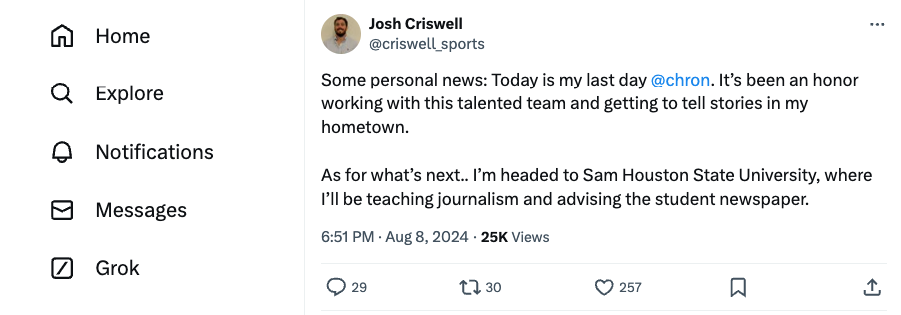
With a media database like MuckRack, you can search for a journalist based on the industry, keywords in bios or articles, or by specific publications.
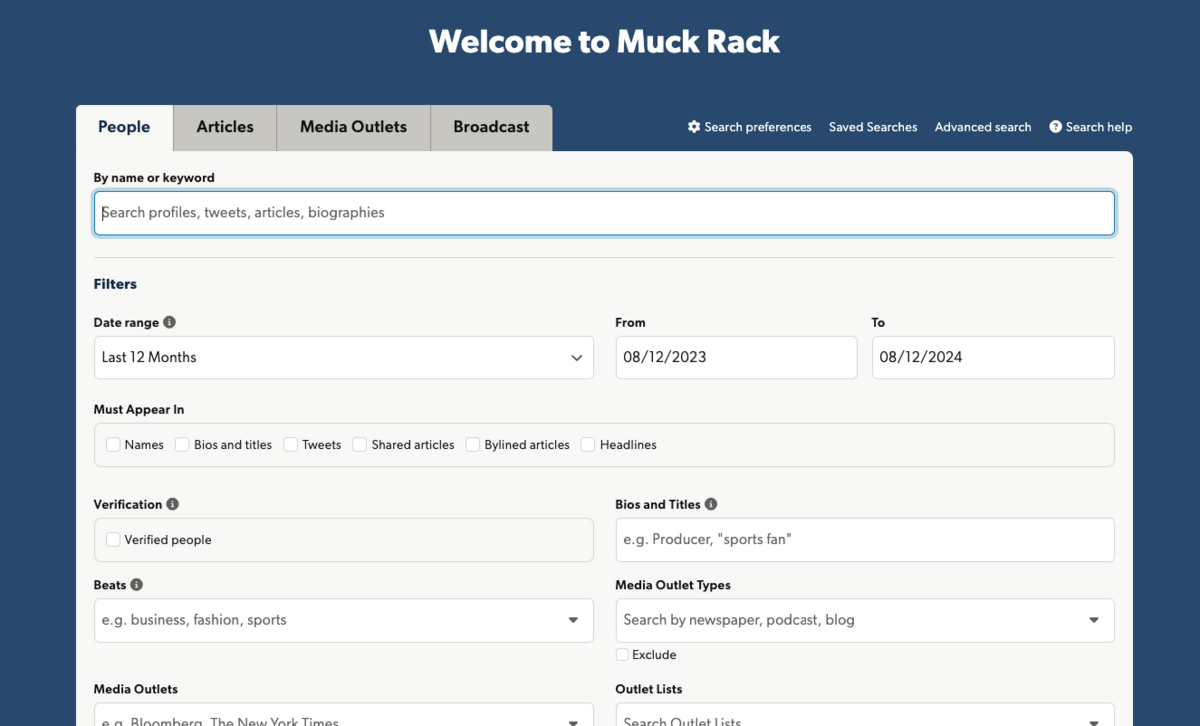
For example, if I wanted to find a journalist who writes about Italy travel tips.
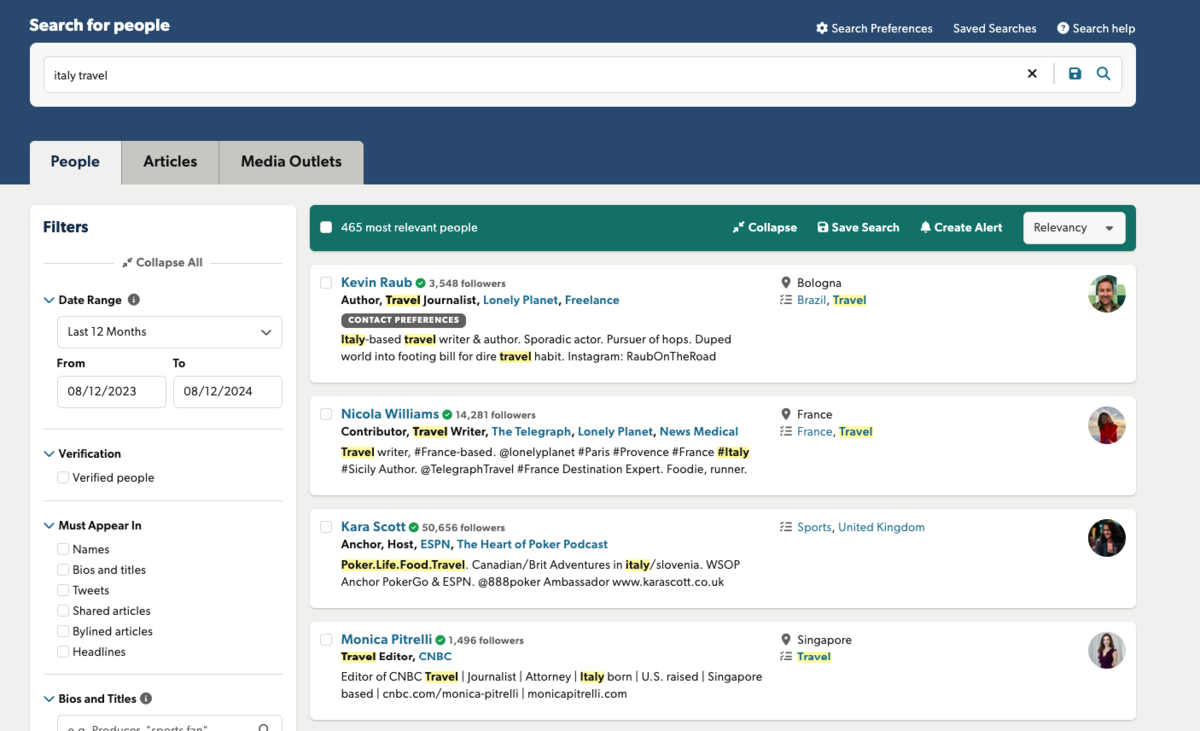
These are great for top-level data gathering.
Phase two for gathering information will be to vet the information and ensure it fits.
For each journalist, however, you must check three things:
- Are they still at the same publication?
- Do they still cover the same industry/beat?
- Have they already covered the same topic you are pitching them?
In other words, you want to find “relevant” journalists for your campaigns.
How to check if they are still at the publication
There are a few easy ways to check if a journalist is still at the publication. The best is LinkedIn.
Most media databases will list a LinkedIn profile; if not, try a quick Google search for the person’s name + the publication.
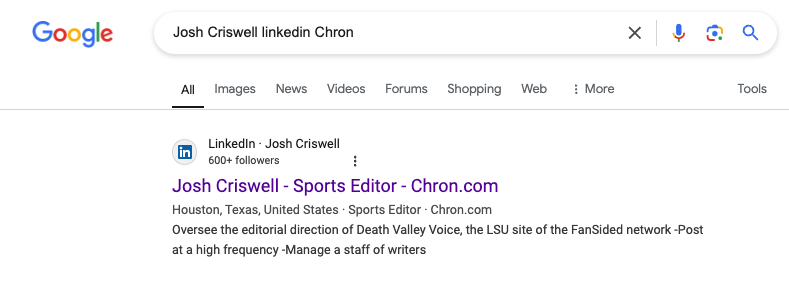
Then, scroll down to the “Experience” section.
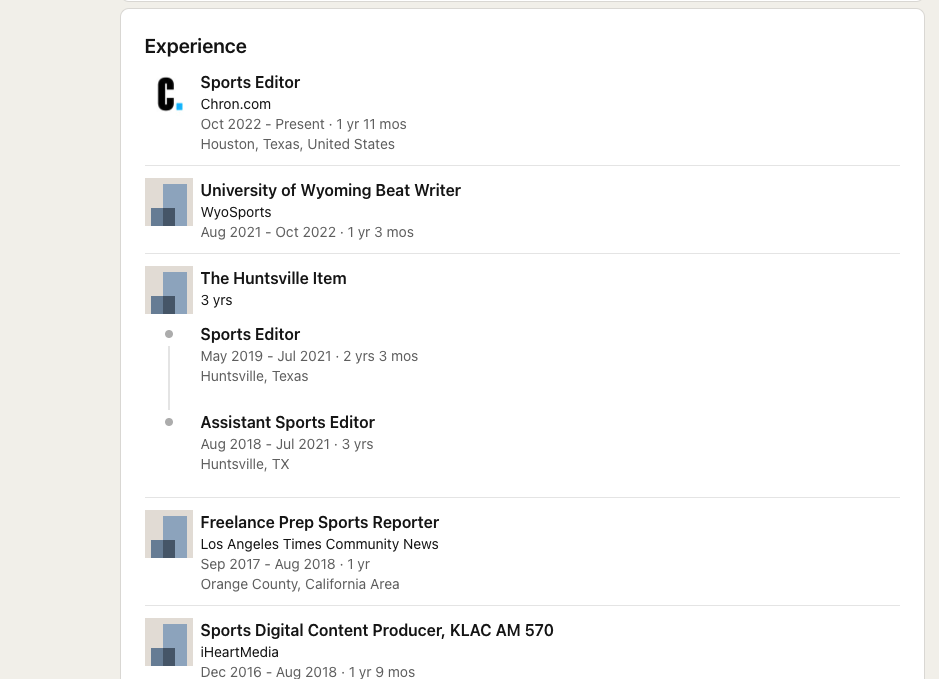
However, as we saw earlier, even this might not be up-to-date.
You can also check X with journalists.
X has a powerful Advanced Search functionality, but a standard Google search usually does the trick.
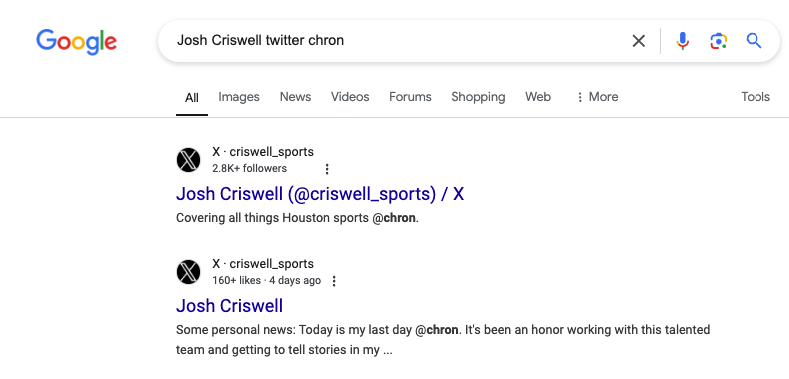
And, as you can see, this journalist in question does not work at the publication.

For the sake of this post, let’s turn to a different example to check a journalist’s beat.
How to check their beat
“Beat” or “Industry” are used relatively interchangeably depending on the media database.
Either way, it is the area the journalist covers.
Relevancy is so vital to journalists.
MuckRack’s State of Journalism report found that lack of relevancy is why journalists reject pitches.
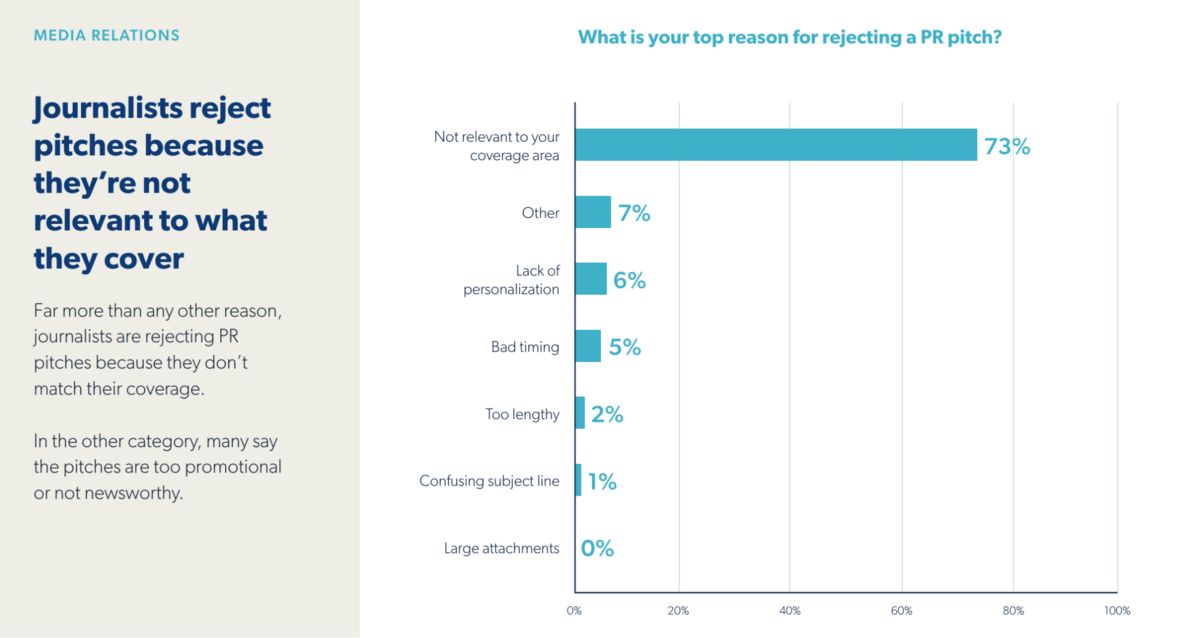
Although media database tools can get you close, I’ve found that relevancy checks take a bit of manual confirmation.
For example, one database may say that someone covers Politics, but when you enter the site, you’ll find that they only cover Right-leaning politics.
Head to their bio first. These can typically be found on their author page.
A quick Google search for Name + Publication + “bio” will uncover these pages.
For instance, Daniel Hall is a rural tourism reporter for ChronicleLive, the Chronicle, Journal, and Sunday Sun.
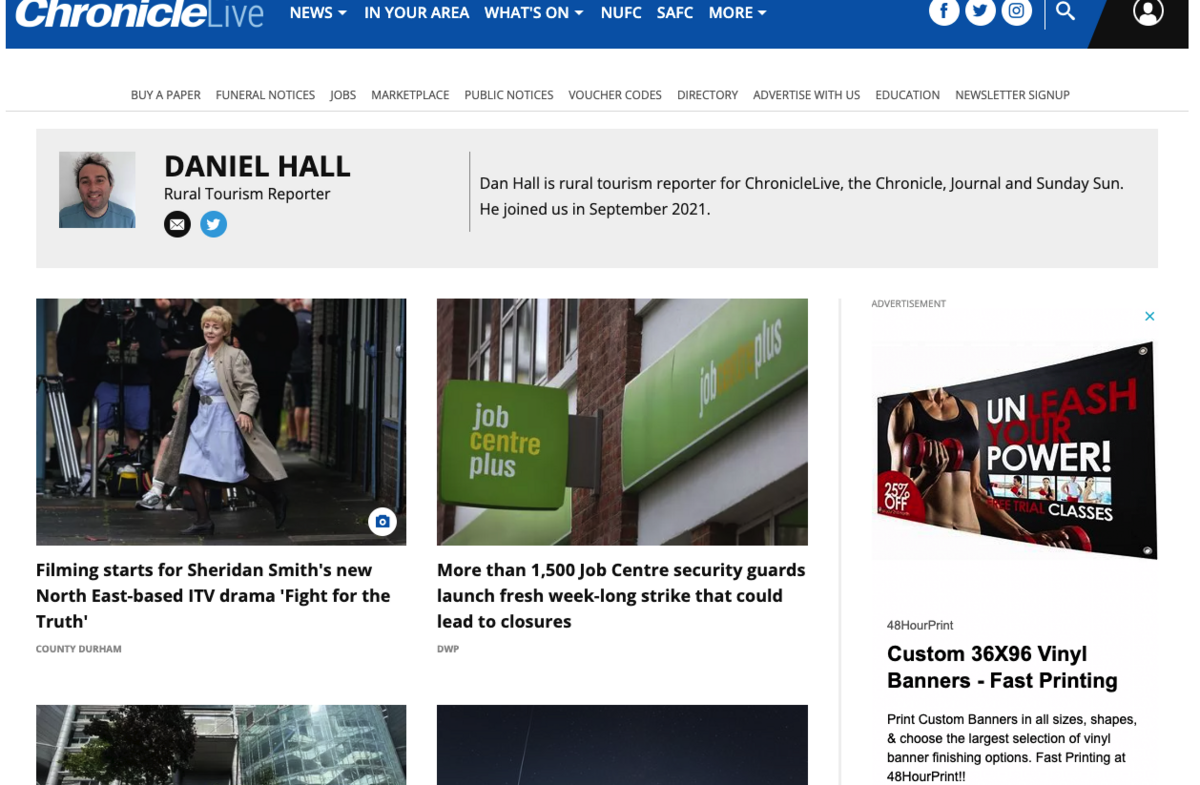
But what exactly does rural tourism cover?
Check the story titles
A look at the titles clearly shows the person’s beat.
From the titles alone, you can see that rural tourism means North East UK.
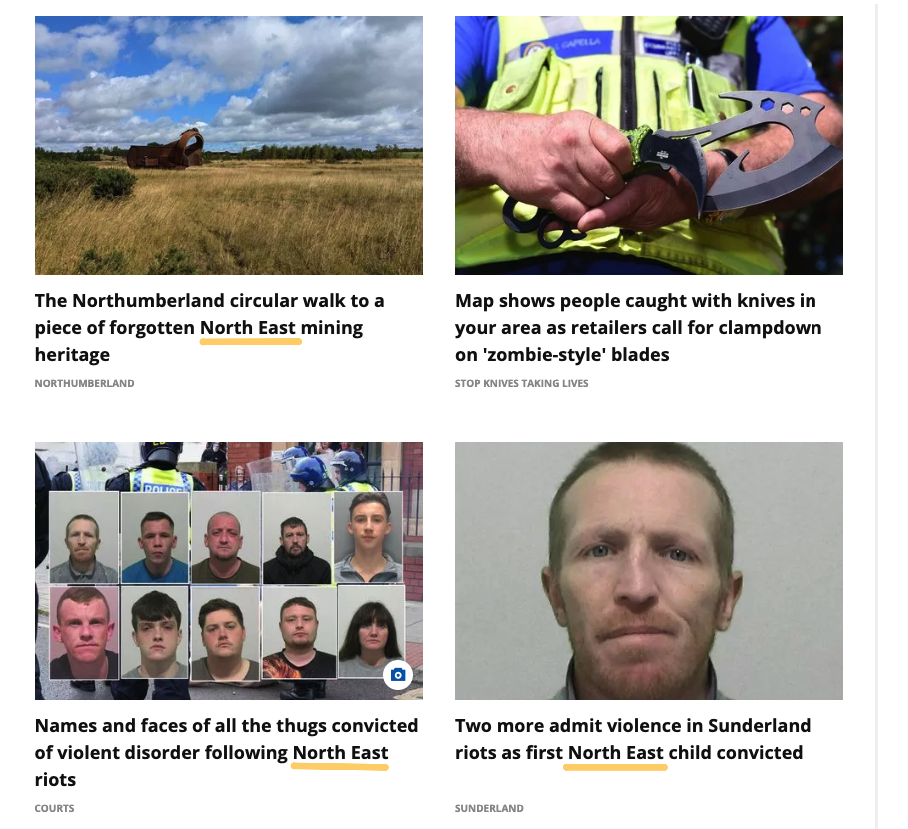
Check the categories or topics
Another tip is to look at the subcategories or topics for the stories.
For example, you can see Sunderland and Northumberland, further confirming the beat is tourism in Northeast UK.

Now we can move on to the last check.
How to check if they have already written about your topic
If you are pitching a new story, the last thing you must do is confirm that the journalist hasn’t already covered the same idea.
(If you are doing some sort of reactive PR or newsjacking, this step is probably unnecessary since reactive PR sometimes requires you to build off of existing stories.)
The easiest way to do this is to Google search for the topic you are pitching.
Journalist name + Publication + Topic.
For instance, if I were pitching the “best cities for sleep” and found Portland to be one of the best cities, I might be tempted to pitch Lizzy Acker.
Lizzy is a reporter on life and culture for The Oregonian/OregonLive.
She’d be a great journalist to cover my story. She has covered a story about Portland and the top 100 U.S. cities for book lovers.

However, a quick Google search reveals this might not be true.
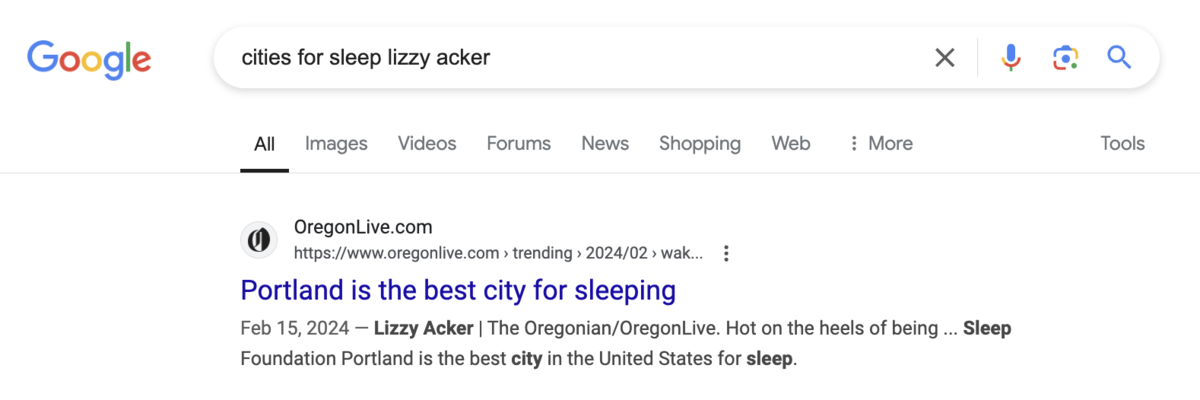
She just wrote about the same kind of study from the Sleep Foundation in February.
So, in this case, I’d consider skipping this journalist and finding one who hasn’t written about the same kind of study.
Let’s take a look at a few other ways to find journalists.
Find Relevant Articles in Google News
Google search provides a direct way to identify articles or publications and find journalists.
Finding relevant articles will typically get you both the journalist and relevant publication for your pitch.
For example, say you want to pitch a story about rising car prices in Texas.
We can search Texas auto news in Google News and set the date range to the past month. This will allow us to find articles written about our topic.
Then, we can find the journalist who wrote the article.

The first result is Dallas News for a piece on auto theft in North Texas.
Clicking on it, we see that Matt Kyle has written the Breaking News Report.

Now we need to run Matt through our previous three checks:
- Do they still work/write for Dallas News?
- Does the beat match our pitch?
- Have they written about this topic already?
In this case, Matt is a breaking news reporter, so this wouldn’t be a good fit because this isn’t breaking news.
Let’s try a different search query to uncover a better fit.
With “Texas news auto business,” we hopefully skew more towards reporters interested in business.

The first result is NBC 5 Dallas-Fort Worth. Here is a post about North Texas and businesses impacted by the global tech outage.

Now, we have to run Vince Sims through our relevancy check.
According to his bio, he is an anchor, which is not my first choice, but it looks like he’s covered two car-related Texas news stories very recently.
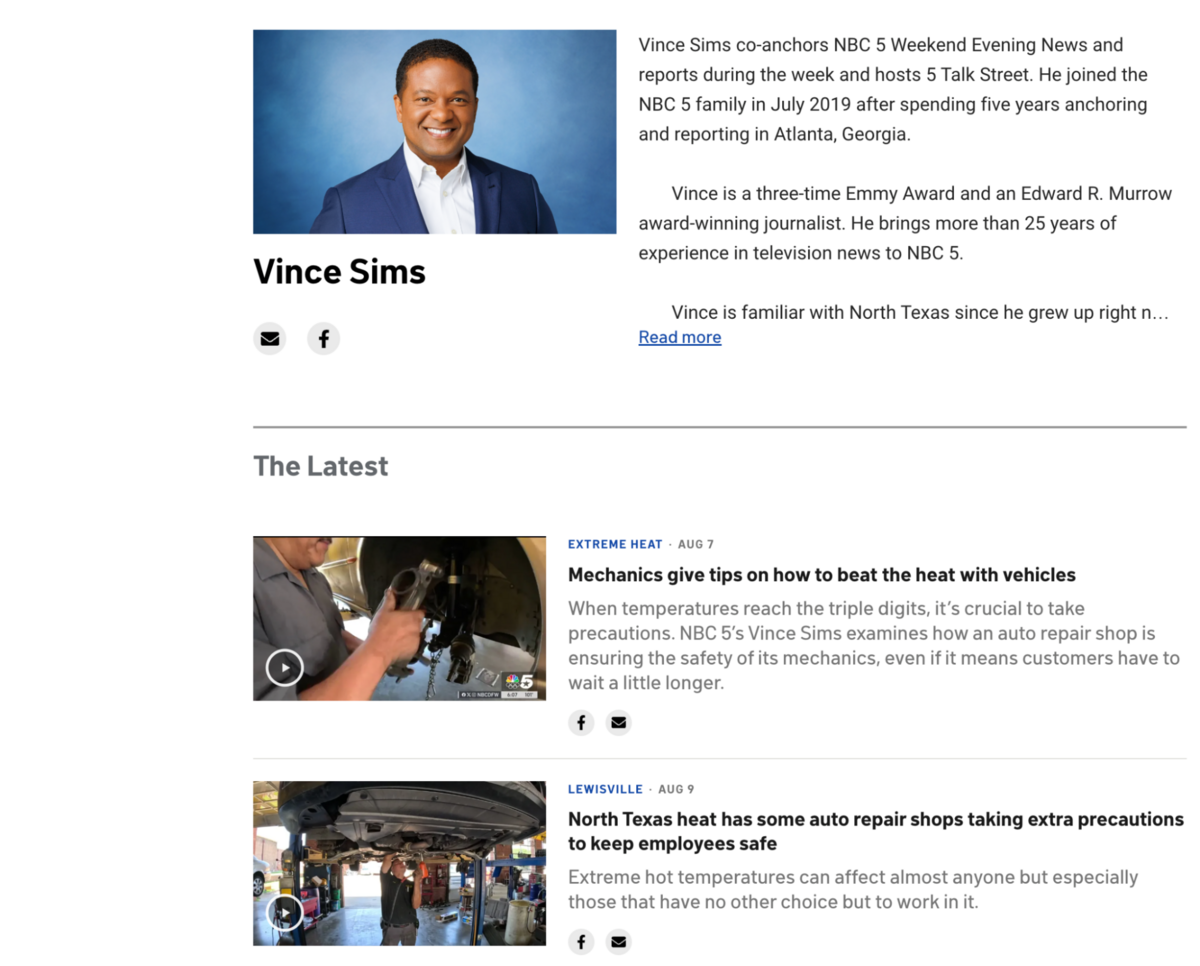
In this case, I’d use him as a journalist.
Digging into each journalist like this is where you will find the best way to connect to them and ensure they are a perfect match for your story or pitch.
Using BuzzStream to Find Relevant Articles
I like using BuzzStream to find relevant articles because it allows me to search for multiple Google Searches simultaneously.
For instance, if I wanted to find “Texas auto news” and “Texas auto business,” I could simultaneously perform a Google News search.
I start by creating a project.
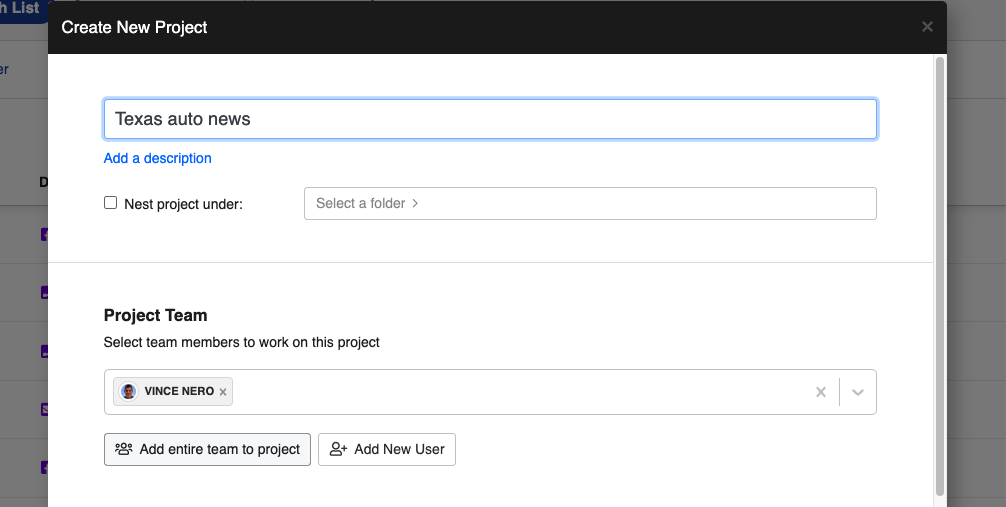
Then, I create a new research list:
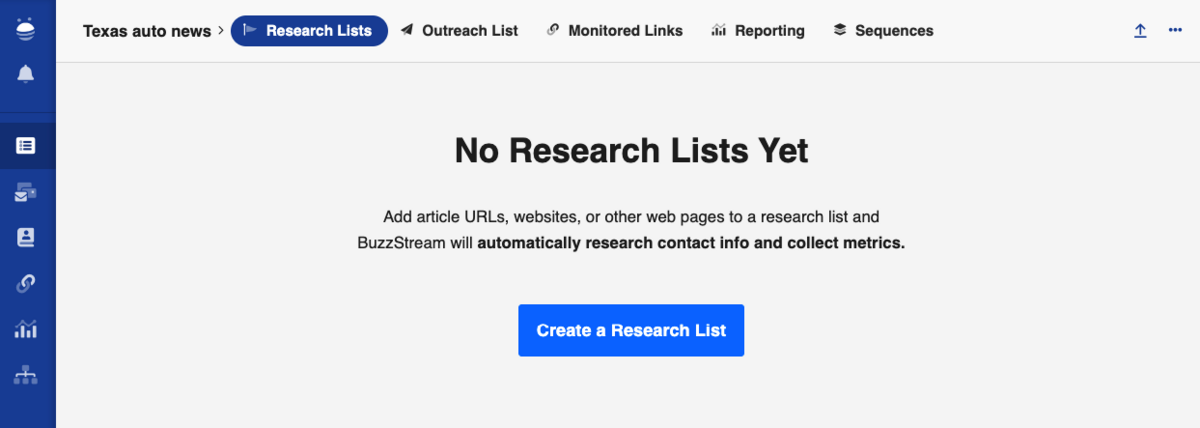
Then, I chose Search News, which allows me to search for multiple queries on Google News.
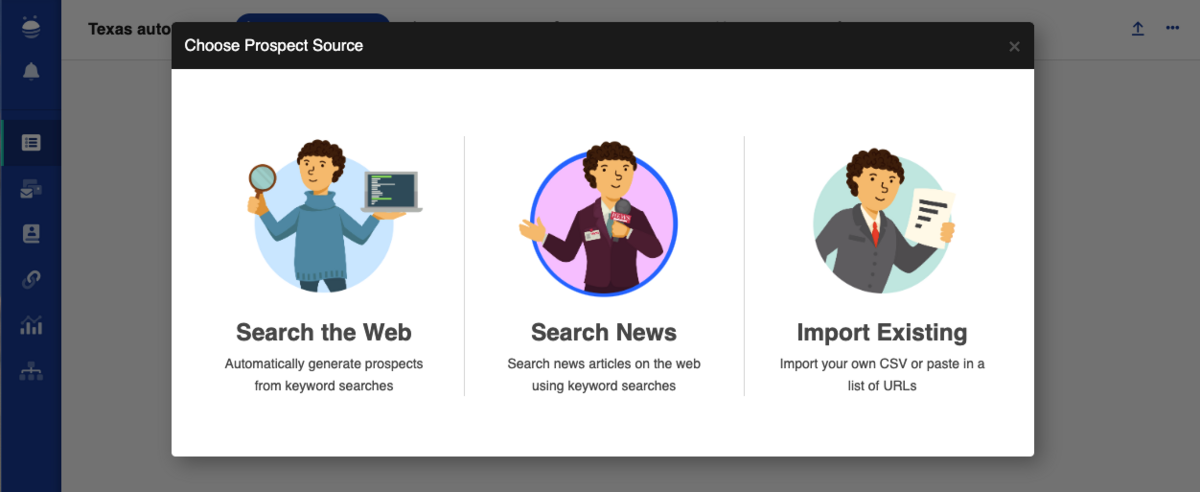
Then I’ll add my search queries and set the date to the past month.
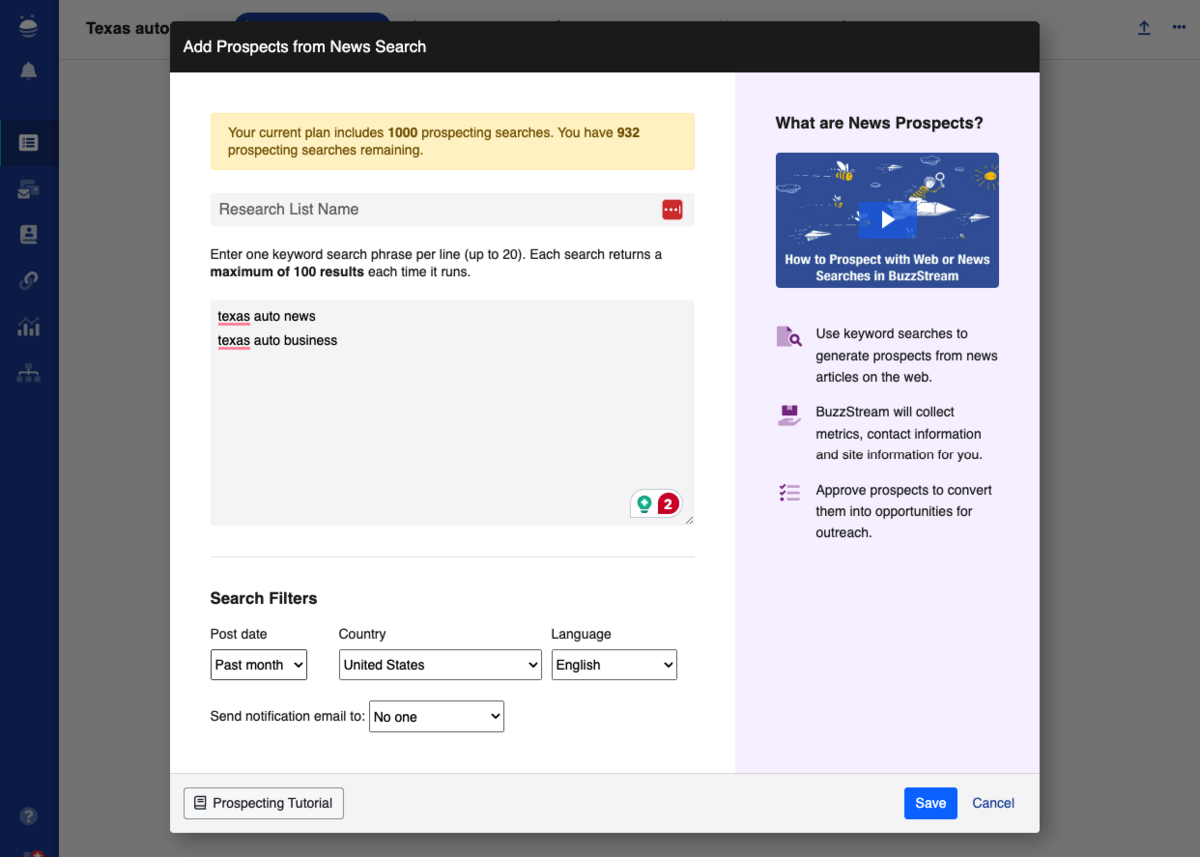
Now, I have a list of sites I can comb through, filter out the noise, and evaluate one by one.
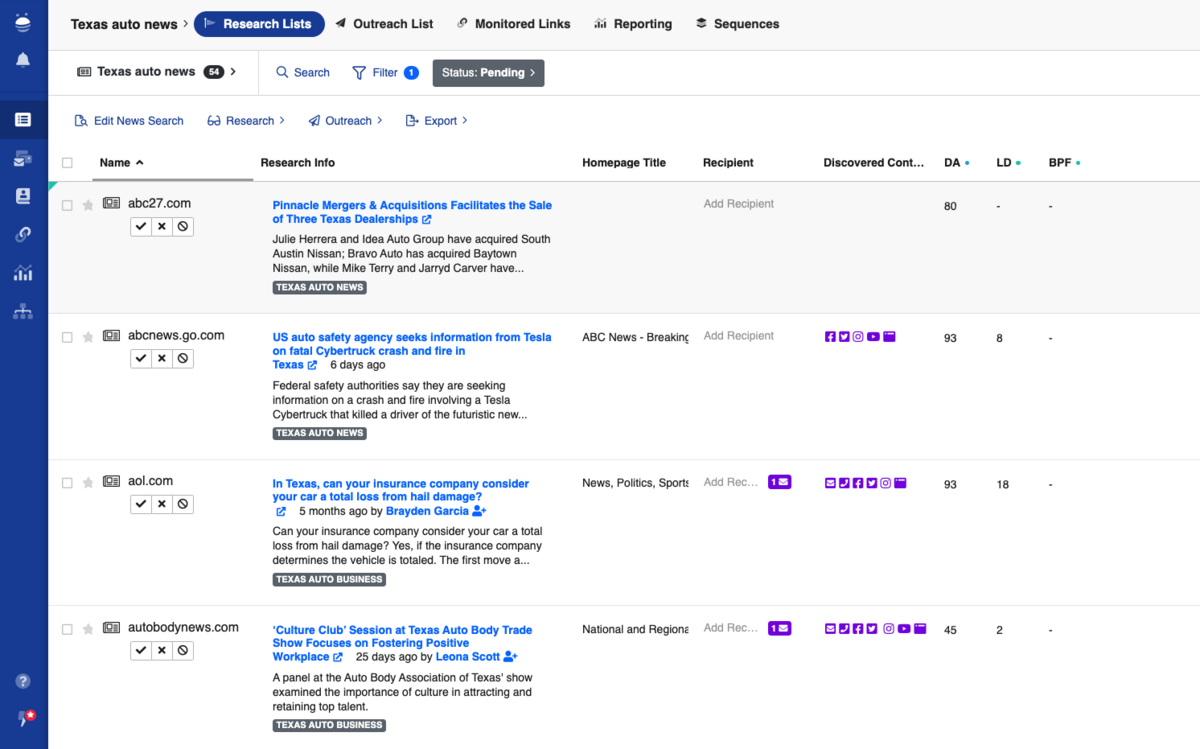
I can filter out the low DA sites to only focus on the highest quality.
Then, I’ll select all of the sites and choose Research.
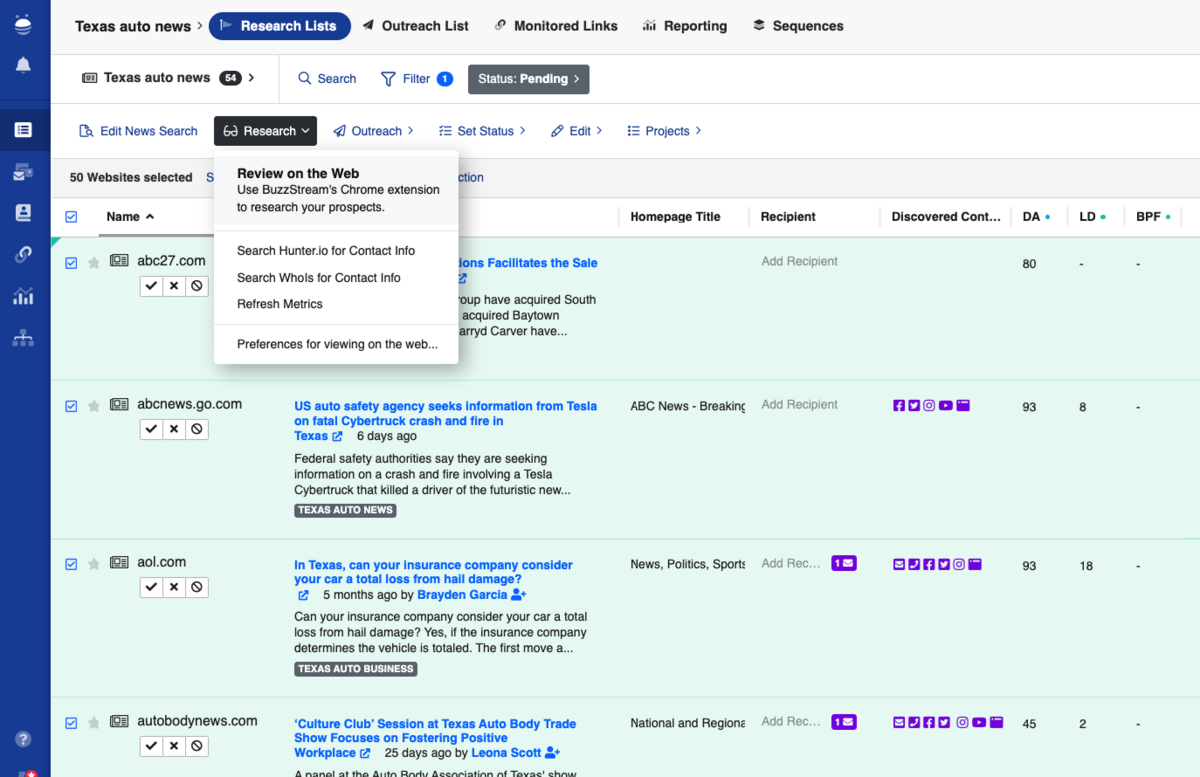
Next, BuzzStream opens up the pages so that I can evaluate them individually.
For instance, here’s a story from Axios Texas that covers Texas car insurance rates:
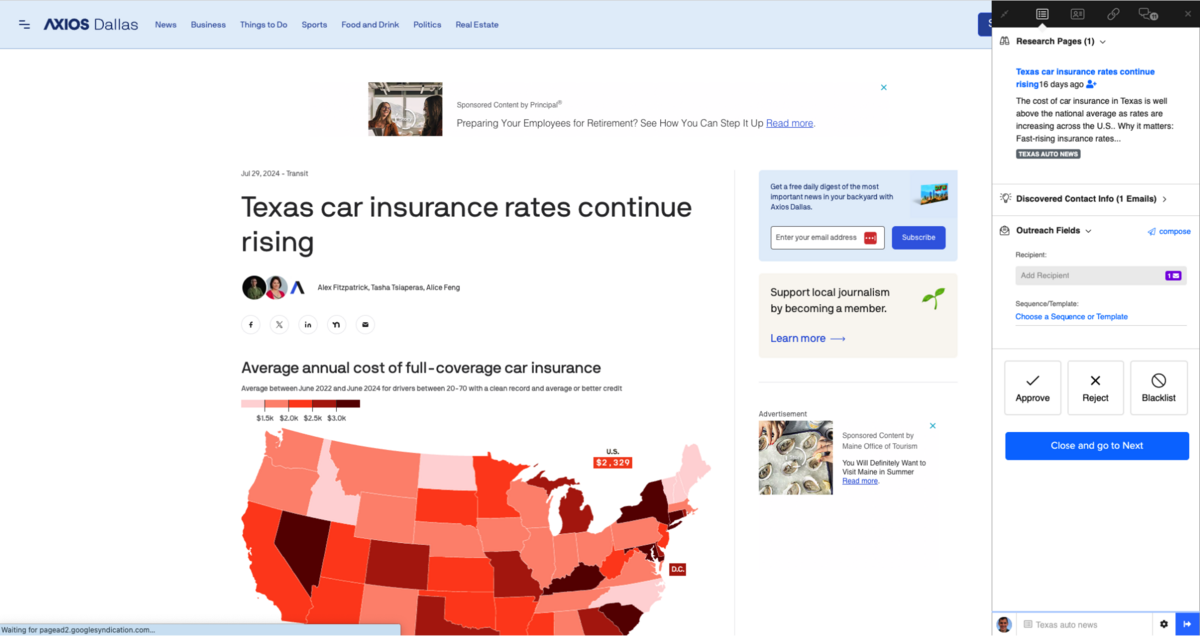
When I click on the journalist’s name, I am taken to a bio page to evaluate for fit.
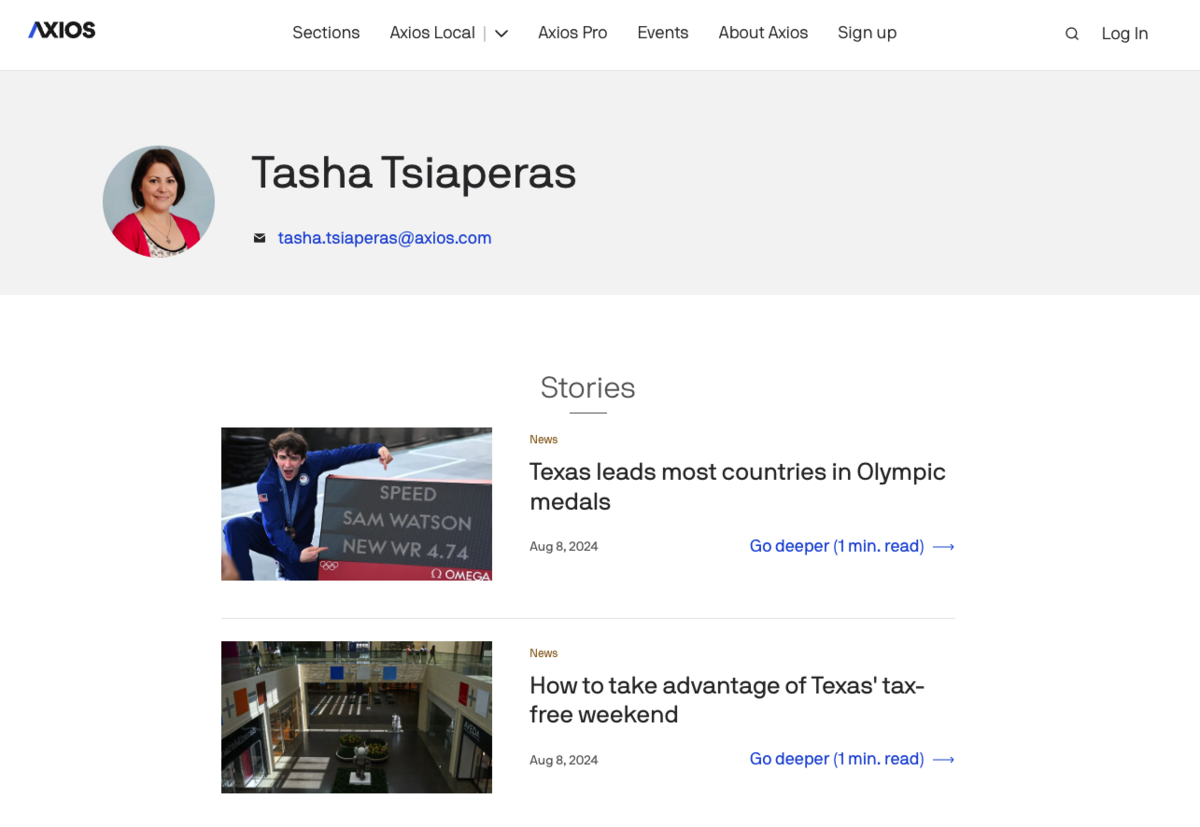
In this case, Tasha seems like an excellent fit for a story about Texas auto prices. I’ll click Approve, which will take me to the next page, and so on.
BuzzStream will automatically pull in whatever contact information it finds, and I can also add anything else I want to the contact.
These contacts become my “outreach list” for this project. I can then draft an email and personalize it, saving me work hours.
Find Journalists at Target Publications
You can also start from the publication and try to find a suitable journalist. You may already know your target publications based on a competitor analysis or stakeholder requests.
If you don’t know the publications you wish to find journalists from, let’s start with that.
Identify your Target Publications
Pretend we are looking to pitch news to Texas.
A Google search for “Texas news sites” will help uncover specific stories about Texas news, like the Texas Tribune, The Texan, and the Texas Observer:
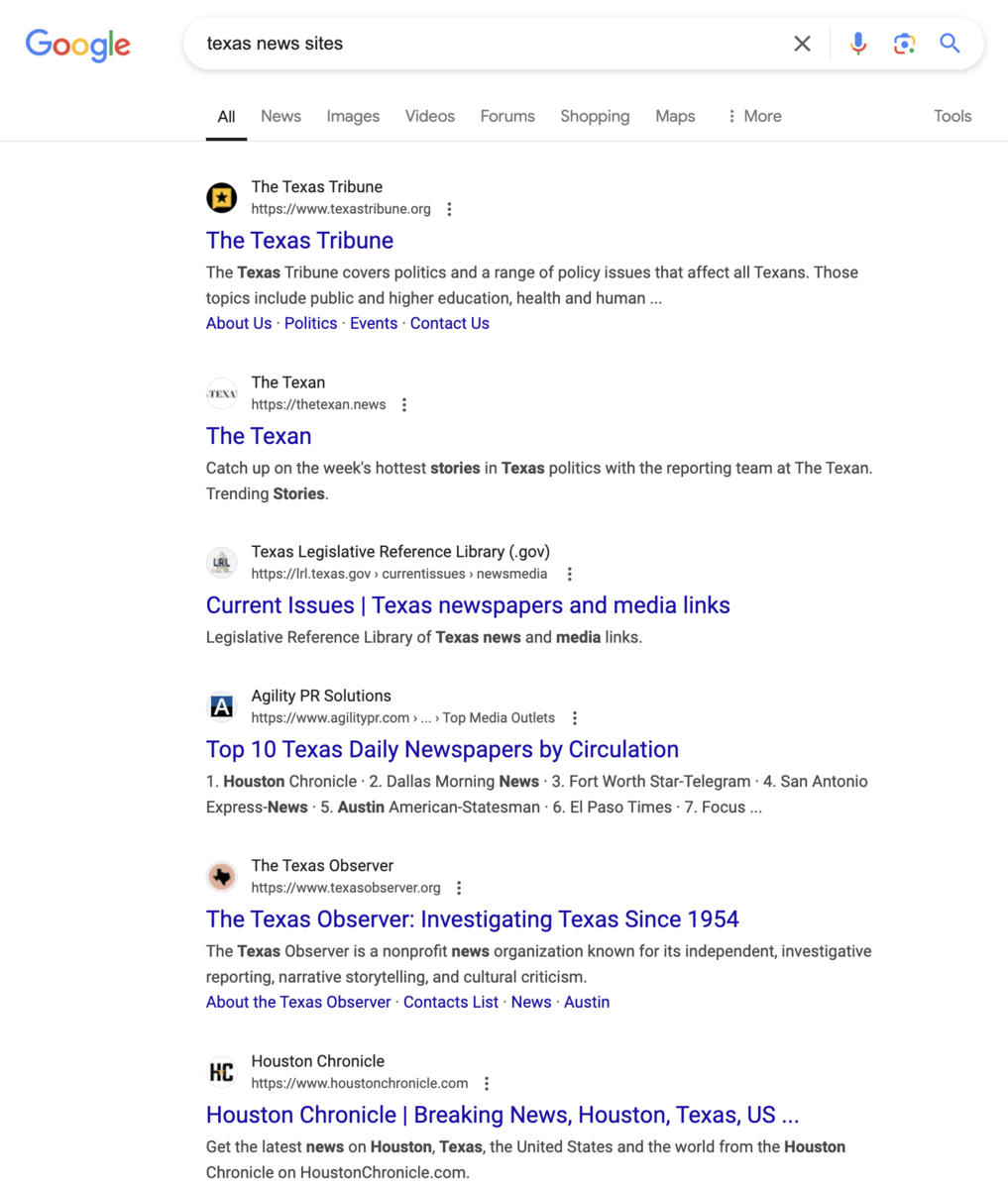
Depending on the story, you may have many angles and kinds of sites you want to target. Google search is an easy way to do this and compile your list of sites.
Once you have the publication, you have to dig a bit deeper to find the most relevant journalist at a publication.
Then, it’s just a matter of clicking on the article, finding the journalist who wrote it, and confirming that they are relevant and haven’t covered the same story.
You can do this by going to the Contact or Staff Directory page, performing a site search, or searching by category.
Find Journalists on the Contact or Staff Page
Most major news publications should have a list of journalists on their websites. You can find these in the “Contact,” “About,” and “Staff Directory” typically listed in the footer.
For instance, the Dallas Morning News has a contact page here:
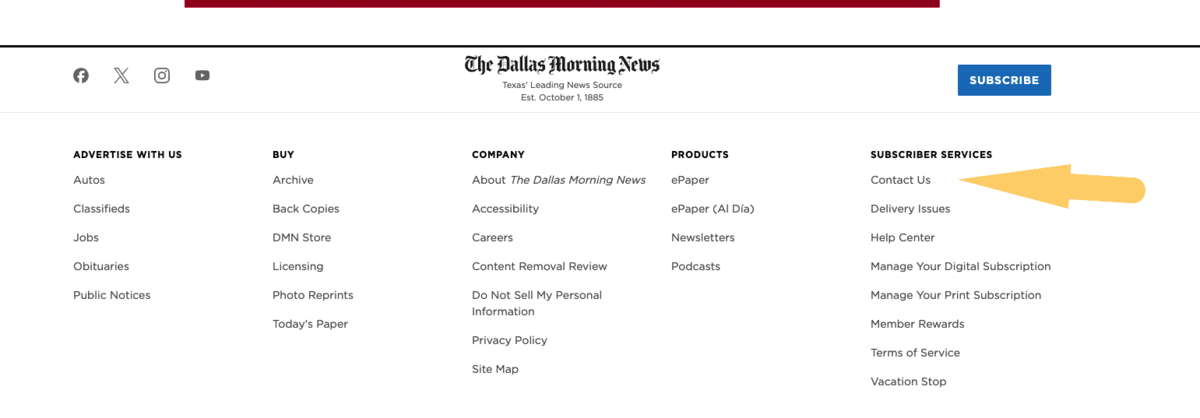
Which lists a lot of their newsroom leaders.

I asked Darren Kingman, founder of Root Digital, about how he and his team identify the correct journalists from a staff page, and here’s what he said:
The size of the publications matters when deciding who to contact with a story. The editor for the NY Times is a very different contact than the editor for a niche industry publication.
The latter will give you a much greater chance of hearing back, while the former will not be able to give you the time of day.
That being said, a journalist who covers the topic of your story is always the first go-to. They are the ones pitching stories internally and gaining approval or not.
They know when they see a headline and if it’s something they can see working.
However, as mentioned above, not all journalists are the same. Favour in-house journalists who have been writing articles for the same publication over the long term.
They’ll likely be busier, but if you cut through, they’ll have much more sway with their editor than a freelance journalist or someone with 6 months under their belt.
When faced with a list of possible people to contact, I’d often rank as follows:
- Reporter/Correspondent
- ‘Editorial team’
- Topic Editor (i.e. Technology, travel, politics, etc.)
- Editor
- Editor-in-chief
The key is to reach the writers directly or through the ‘editorial team’ email address or contact form.
The editors would be after that.
They set the tone for the publication and can distribute articles to writers. Still, the nature of their jobs implies they have less time to read through your story, the press release, methodology, etc., and therefore, less likely to be seen – even if they are making the decisions.”
So, based on Darren’s advice, we could contact Amy Hollyfield because she is a managing editor, but ideally, we would find a reporter.
So, let’s try a site search.
Site Search
There are two ways to search a site. Some news sites have a search tool.
Otherwise, you can use a Google search operator site:
So, if we were pitching a story about auto prices, we could do a site search for “auto news.” Then, set the time frame to one month to find the most recently written stories.
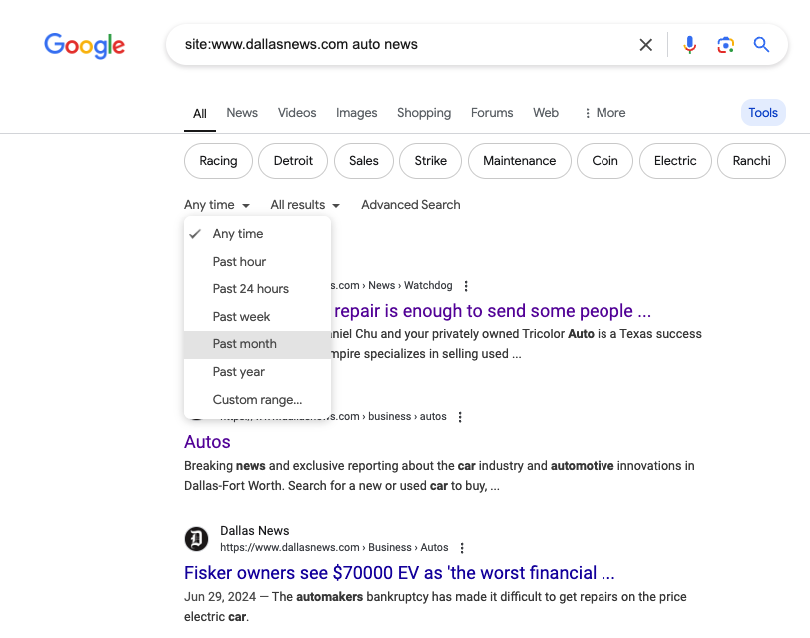
This will uncover articles written at The Dallas News that are about cars.
Then, you can click on each article, identify the journalist, and run your relevancy check.
For example, the first result is a story from Dave Lieber, who writes about consumerism.
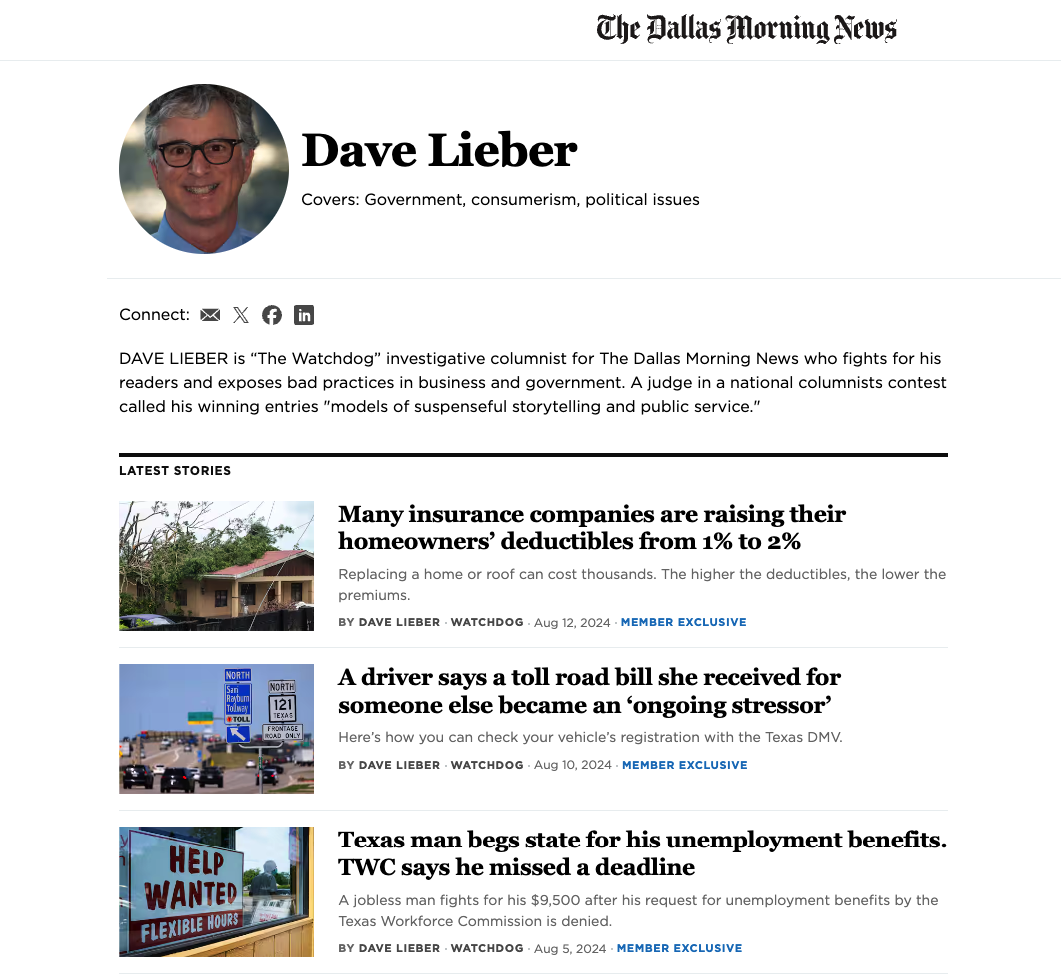
He may be interested in our story of rising auto prices in Texas — especially if the reason concerns federal interest rates.
The last option would be to check the category pages
Category Page
Every news publication does an excellent job of categorizing their content.
The categories are typically listed on the homepage or in a drop-down menu in the top navigation bar.
In the case of The Dallas Morning News, we can find an automotive news reporter by clicking into the Autos section of the site:
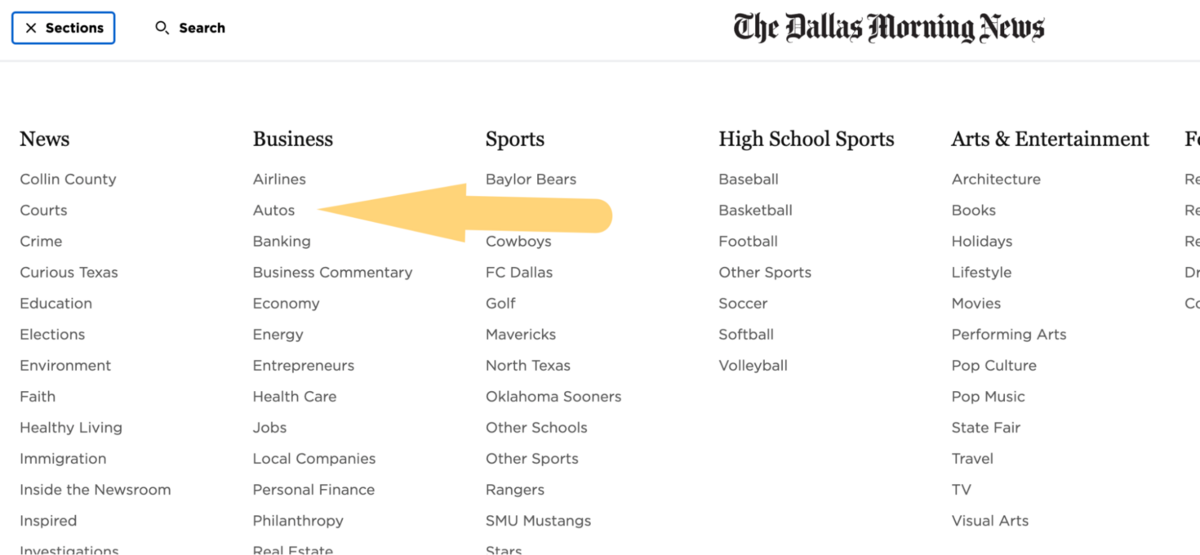
Then, it’s a matter of surveying the content and seeing if you can find a journalist who has written about a relevant piece of content.
Here is one from a journalist named Irving Mejia-Hilario.

Clicking on Irving’s name brings me to his bio page.
Irving Mejia-Hilario may be a great fit, especially since he was previously an Automotive News reporter.

Using BuzzStream to Find Target Publications
You can use BuzzStream to find target publications, as I used it to find relevant articles.
Instead of using the Research List building tool to find Google News articles, I use a general Google Search.
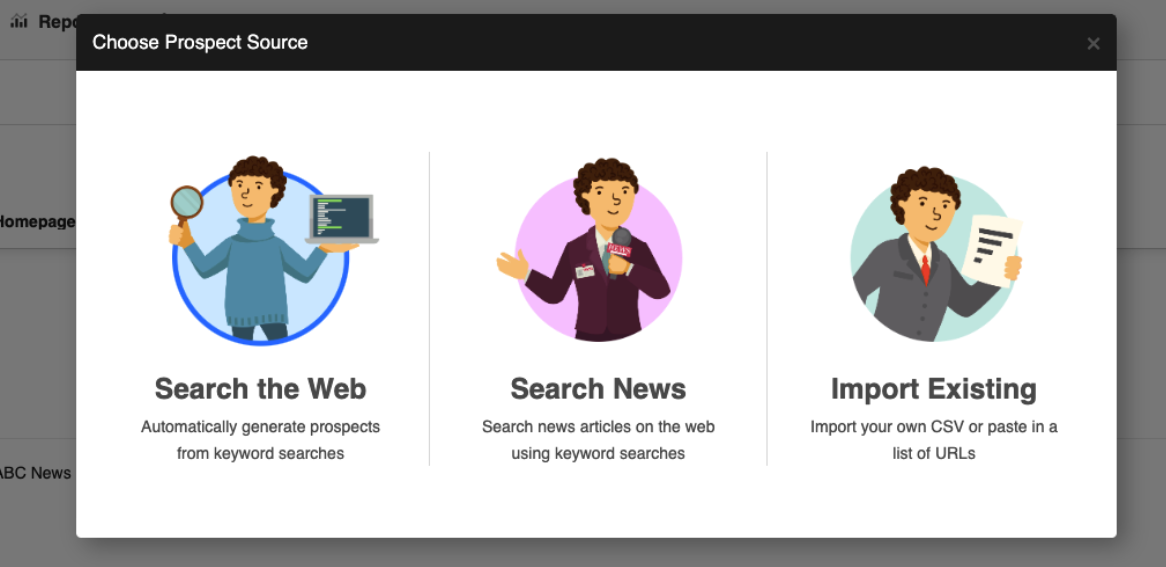
Instead of searching for articles, I initially use a more general search term.
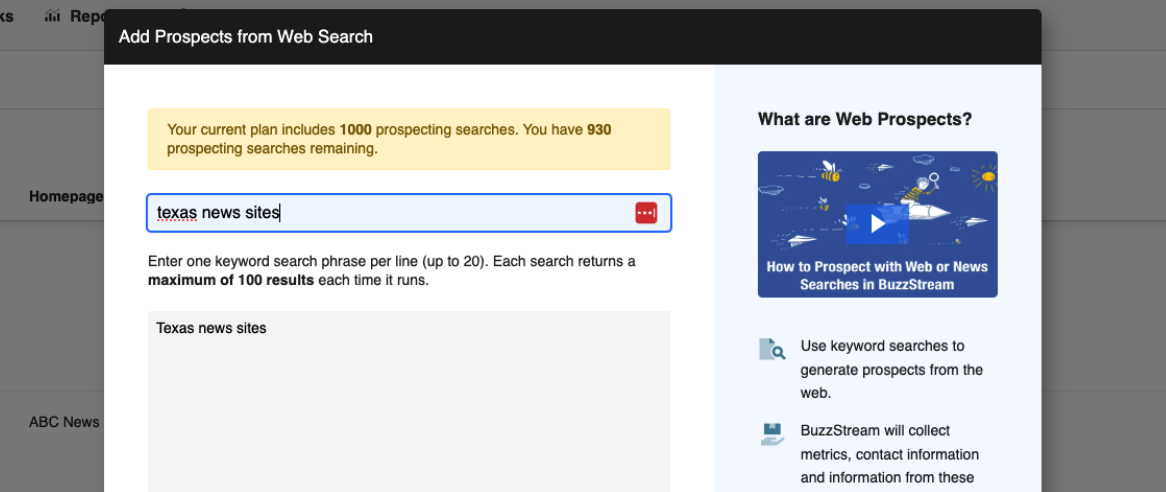
Then, I go through the site-by-site process and identify relevant news publications.
I can use filters to filter for high DA sites. I’ve set it to display everything over DA 75:

Then, I evaluate the pages and run the previously-mentioned processes to identify relevant journalists at those publications. First, I select all of my sites and go to Research.
Then BuzzStream opens the sites in the list in new tabs to help me determine whether sites like The Austin Chronicle have a journalist that would fit my media list.
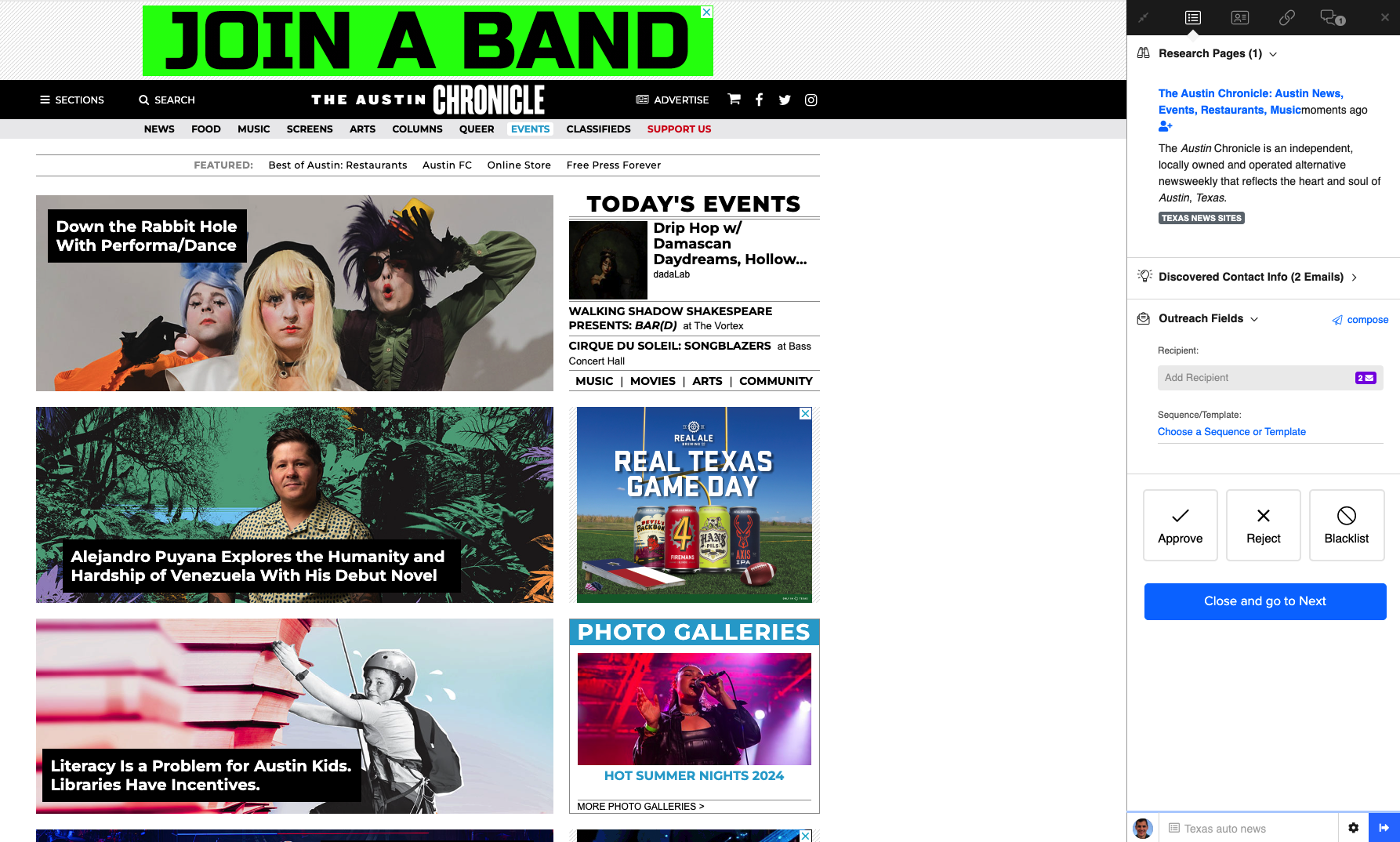
BuzzMarker pulls in contact information for journalists (which I’ll discuss in the next section).
Social Media
Journalists can also be found on social media. I’ve found that journalists are most active on Twitter/X.
You can find journalists relevant to your pitch in a few different ways.
X Advanced Search
Twitter/X has an Advanced Search tool that you can use to find journalists.
For instance, if I was looking to identify journalists who covered consumer affairs, I might use a search query like this:
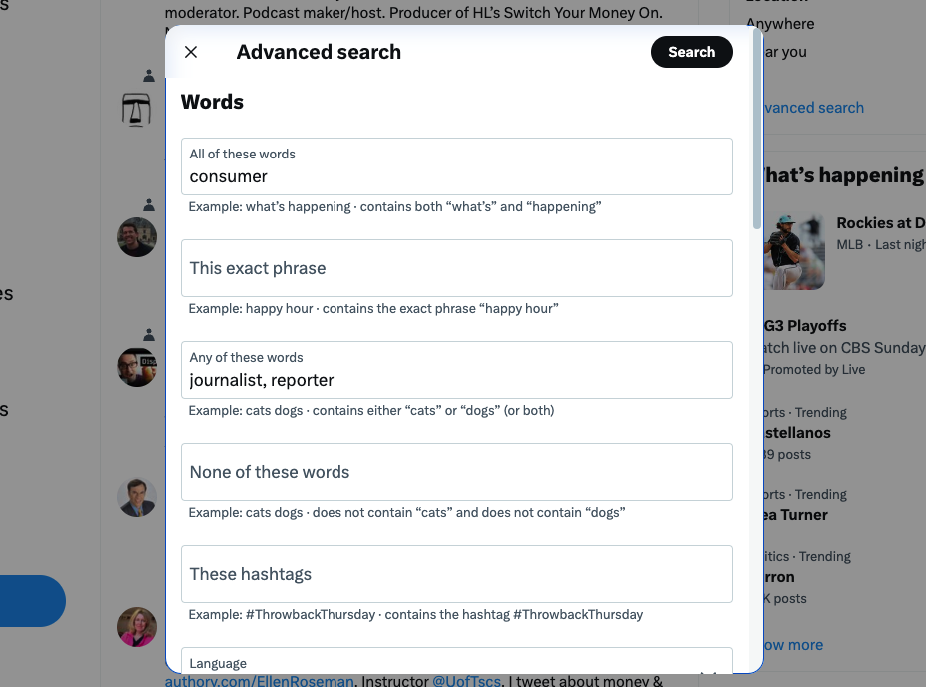
Then click on the People tag, scroll through to each of these journalists, and measure their fit.

Hashtag Search
One of the things that Jodie Booras recommended in our post about creating and pitching a “city study” was utilizing hashtags.
In the post, she mentions using hashtags is “even better. Not only will these types of searches help you find publications, but they will also likely show you who specifically to pitch.”
Using Twitter/X Advanced Search, you can specify hashtags and find users talking about them.
Let’s try #consumernews to find journalists posting about similar stories.
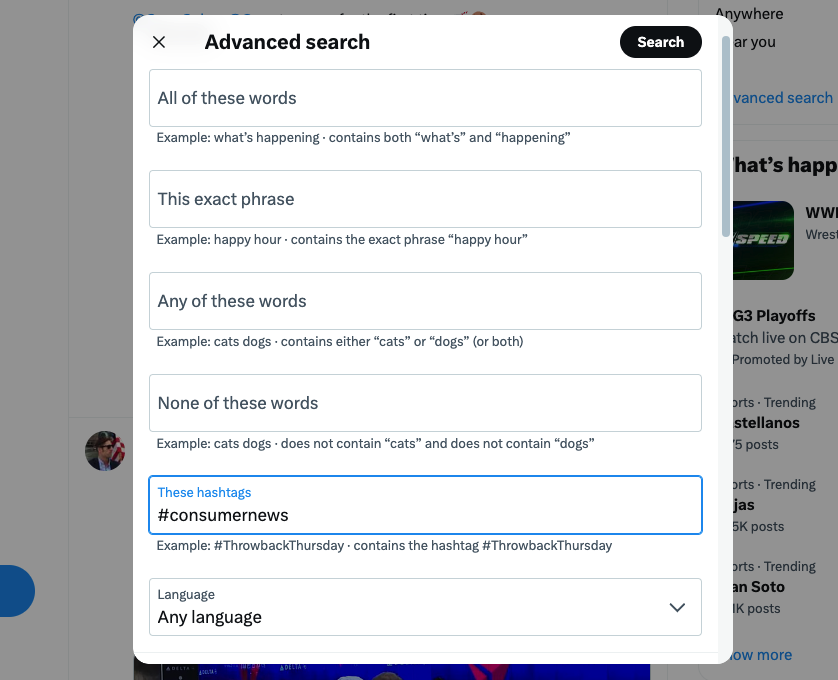
For example, Dean Kurth talks about #consumernews.
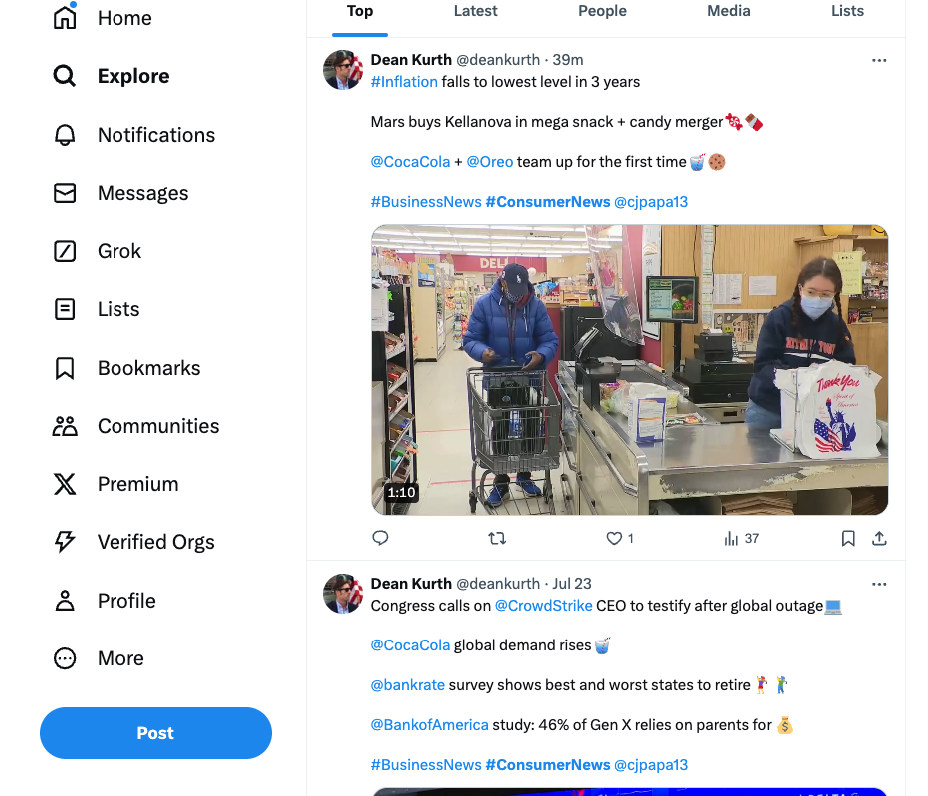
When I click on Dean’s profile, I see that he’s a Fox News Producer and could be a fit for pitching.
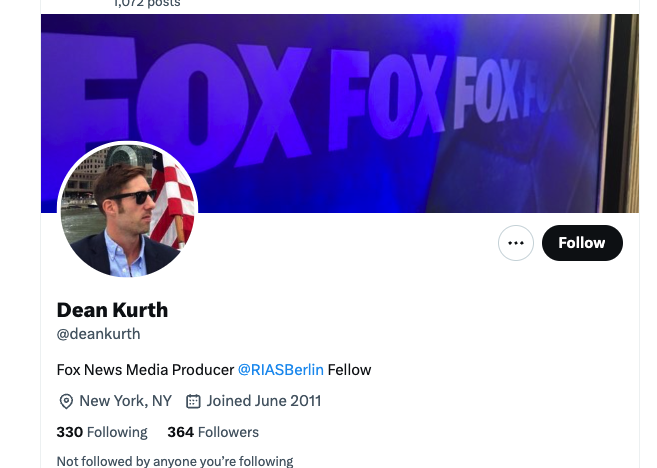
But don’t stop at just Twitter/X. You can search hashtags on other platforms to find stories and people talking about the same topics you wish to find.
If I search #consumernews on Instagram, I find thousands of posts around the topic.

Clicking into them, I see that some are news stations, which I can then dig deeper to find the correct contact using the steps above.
Or I may find individual reporters’ profiles, like this one from @TheSashaShow:
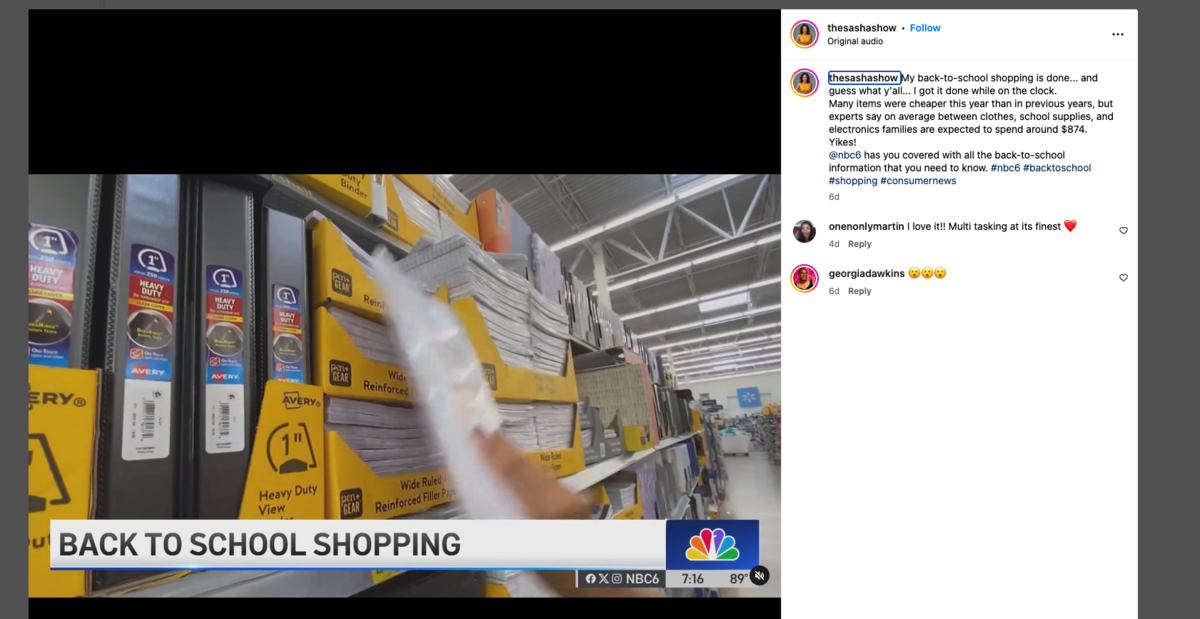
When I click on her profile, I find that she is a consumer investigator, perfect for a pitch about a consumer-related story.

After finding the person, the last hurdle is usually finding their contact information—specifically their email address.
Let’s get into that next.
How to Find Their Contact Information
I’ve written an entire article about ways to find someone’s email address online, so I’ll just cover some of the basics here.
BuzzStream
BuzzStream will uncover any available contact information on a particular website.
So, to find journalists, I’ve seen it most straightforward to use the Chrome Extension BuzzMarker when I’m on a website. The BuzzMarker scans the site; if it finds an email address, it will extract it for you.
For example, I mentioned Vince Sims from NBC in one of the sections above. You can see that when I opened BuzzMarker on NBC, BuzzStream found his email address and everyone else available on the site.
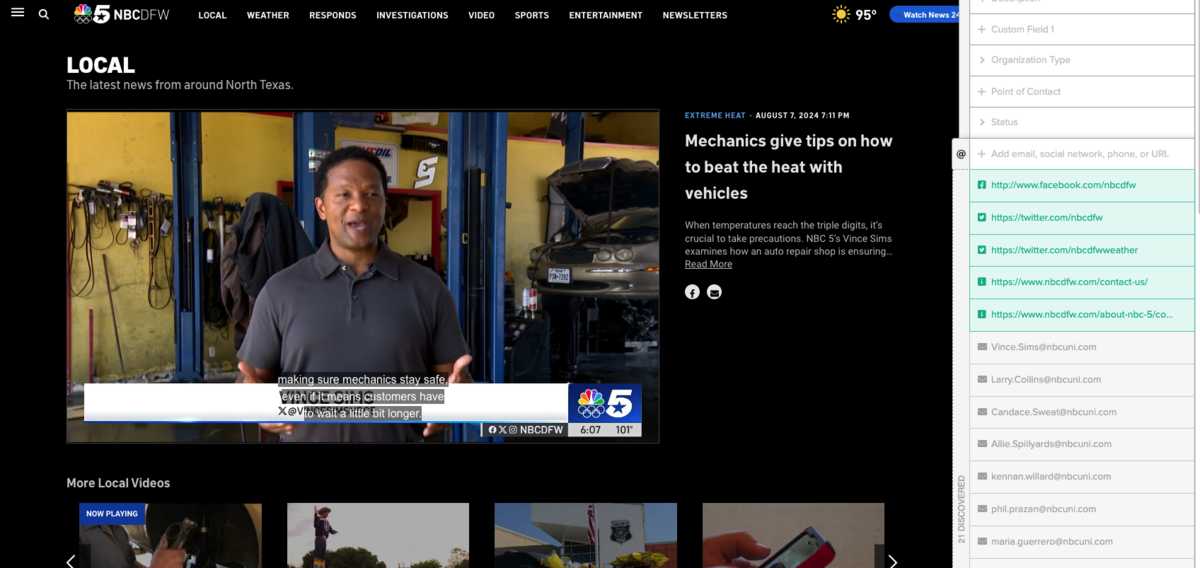
Sometimes, it’s not always possible to find the email address. Hunter can extend the reach a bit, or give you some clues.
Hunter
Hunter.io is an email finder tool that can help uncover journalist emails. What I like most about Hunter is that it gives you its best guess at the email pattern.

Tip: Hunter can also extend BuzzStream’s reach. If you have a Hunter account, you can sync it with BuzzStream.
Contact Page
I mentioned this earlier, but most publications have a Contact Page, Staff Directory page, or Author bio page.
Most author bio pages provide the email address directly along with the bio.
For example, here is a journalist who writes for Axios, with her email listed directly on the page:
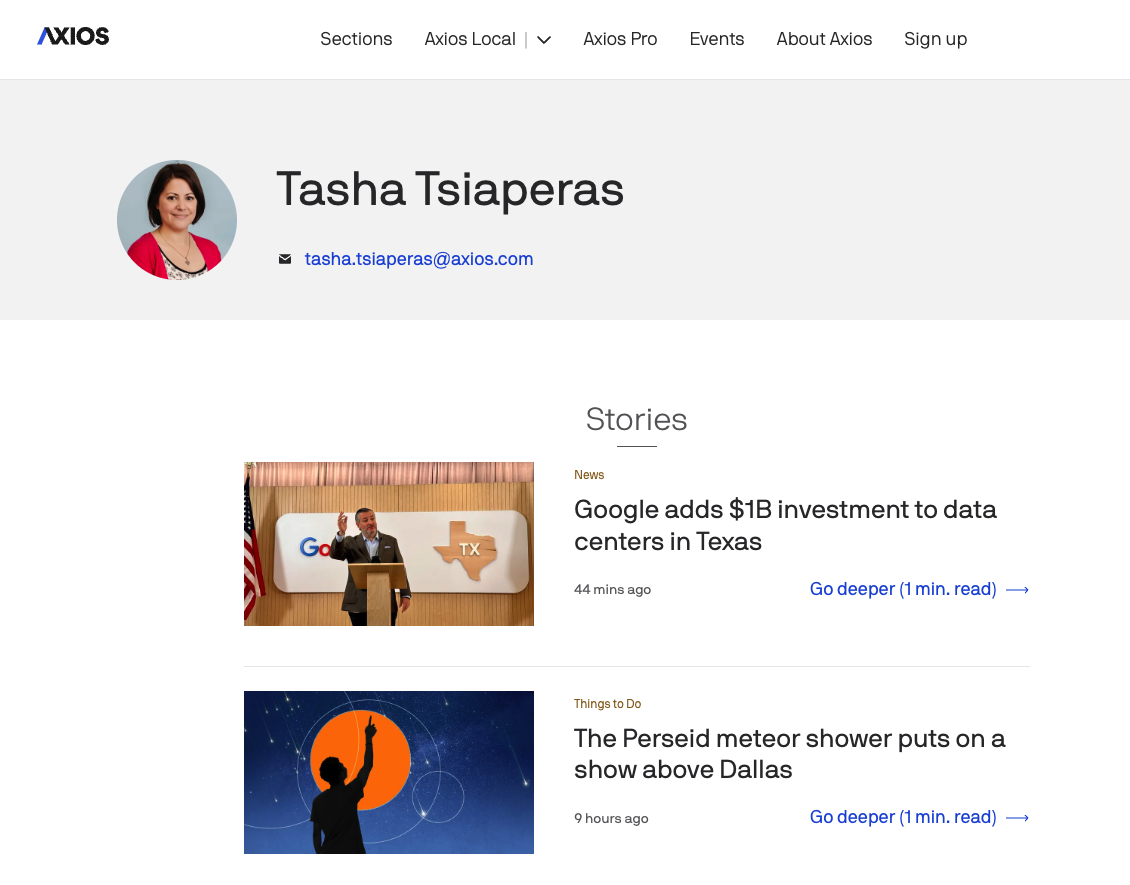
However, when they don’t, you may have to use third-party sources, like social accounts.
I’ve also been using a tool called Wiza a lot recently. It syncs with LinkedIn to uncover journalist email addresses (and phone numbers).
As long as a journalist has their publication email account associated with their LinkedIn, it should uncover the contact information.
For example, if I tried to find Tasha Tsiaperas’ information on Linkedin, I did a quick Google search of her name + LinkedIn.

Then, using the Wiza tool, it will cross-reference their database and pull the email address associated with the name.
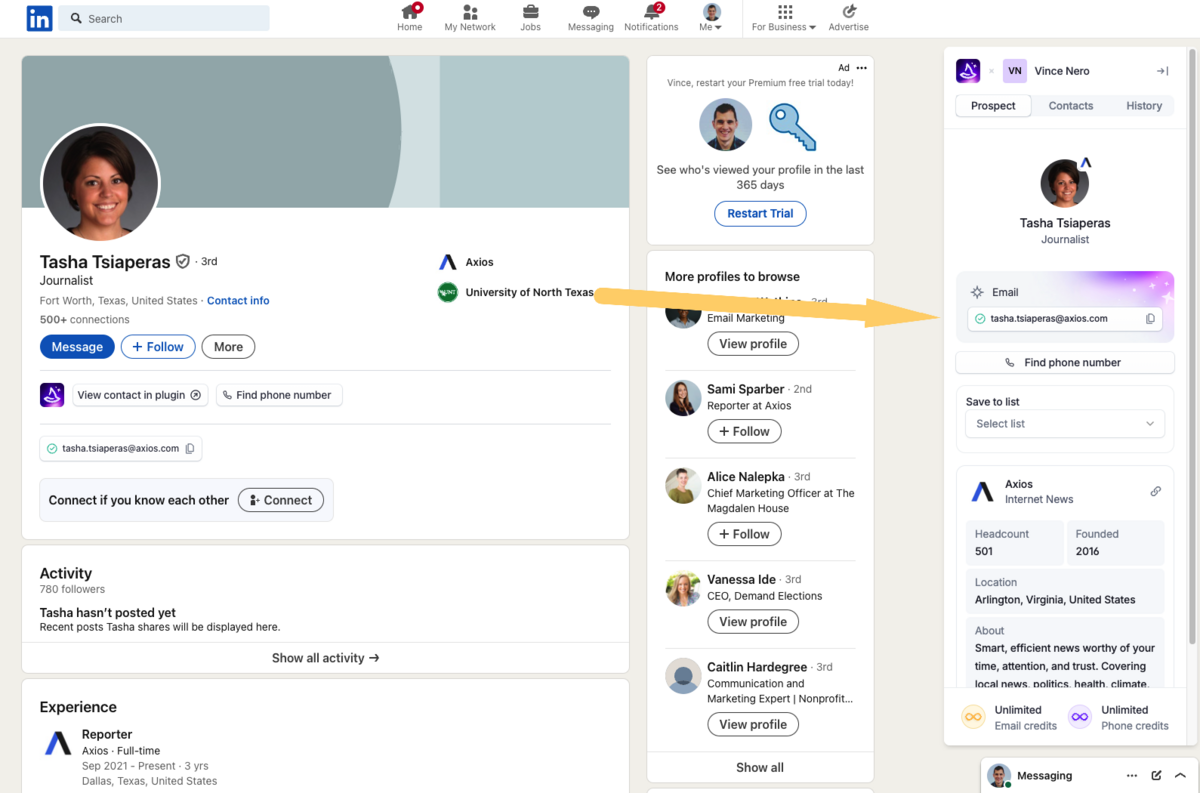
But outside of those three tools, Twitter/X has been one of the best places to go.
Twitter/X
Most journalists who want to be found will put their email addresses into their profile.
For example, here is Victoria Giardina’s email address for the NY Post.
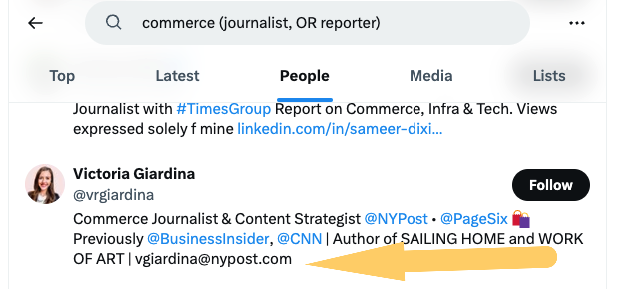
Now that we know how to find journalists let’s quickly touch on how to contact them.
How to Contact Journalists
As I mentioned in my post about contacting journalists and reporters, it is best done by email.
MuckRack’s State of Journalism backs this up with their data point that 83% of journalists prefer to be pitched via 1-1 email.
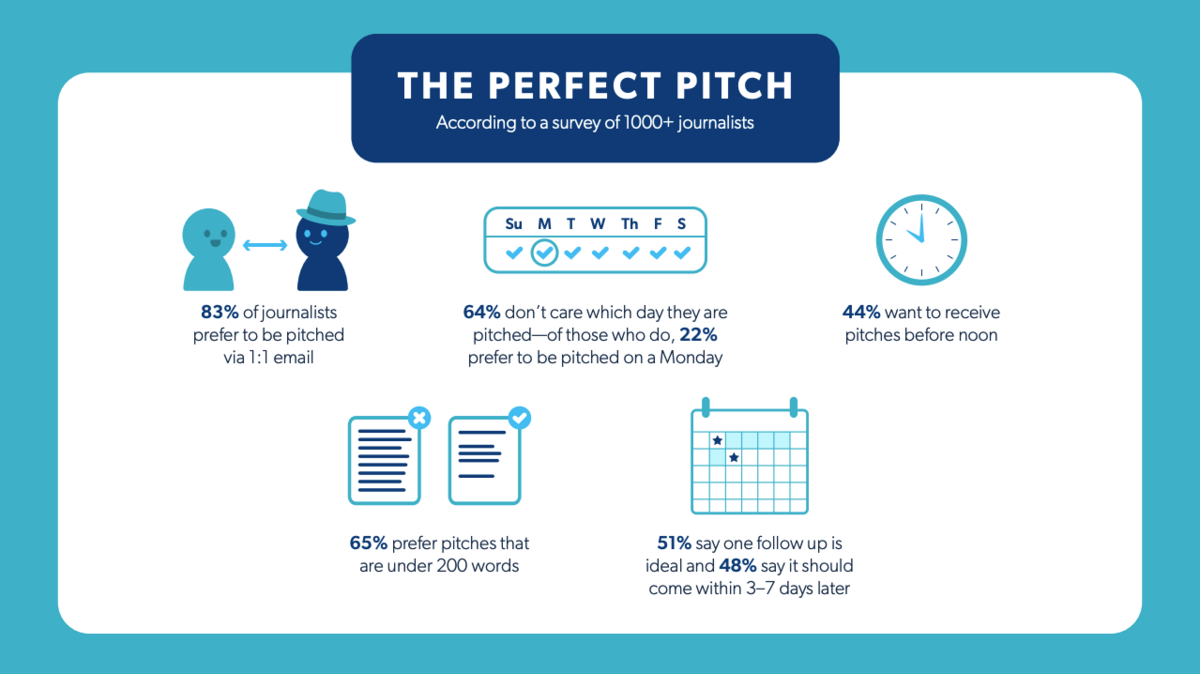
So here are some quick tips for emailing and contacting journalists using other methods.
Emailing Journalists
You can read more about crafting a great media pitch from Hannah Smith.
Instead of sending out generic mass emails, I always craft individualized messages that resonate with each journalist’s interests and beats.
“Personalization” can mean different things depending on who you speak with. It can be as simple as matching the beat, but it can also be making a connection to something in a bio or social post.
However, phony email outreach personalization can halt your progress. So, if you are going to do it, make sure it’s authentic.
In my years working in digital PR, I’ve (unsurprisingly) used BuzzStream because it allows me to do everything I just mentioned. However, I’ve tested other digital PR tools.
Contacting Via Social Media
Gabriela Covay, from Bright Valley Marketing, told me that “an alternative to emailing journalists is reaching out through their social channels, notably X.
Many journalists also have an Instagram or Facebook account; contact them via the channel they’re most active on.”
I usually take a two-step approach: comment on a Tweet and then reach out via DM, so I’m not cold-messaging them.
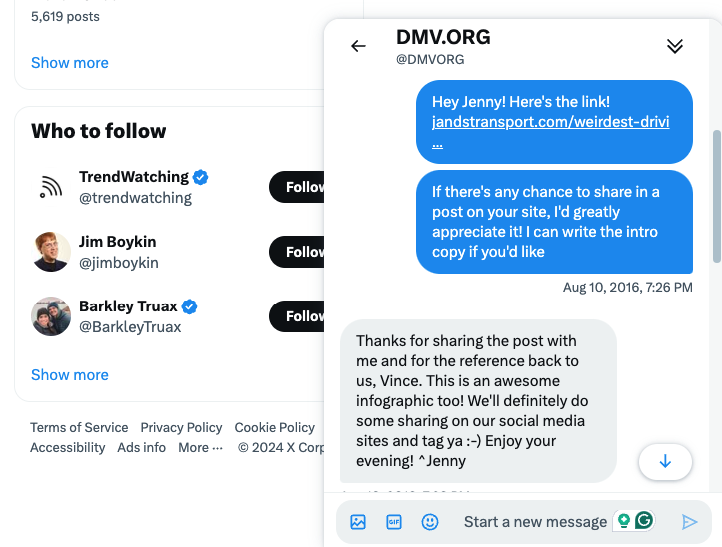
Calling Journalists
Most link builders or SEO-turned-digital PRs sleep on calling a journalist.
And it’s true, not every journalist prefers to get called. But, as Gabriel went on to say:
Surprisingly, calling can be an incredibly effective way to pitch your story. It’s not a commonly used channel because most people avoid calling journalists directly.
Sure, sending your pitch via email is easy and convenient, but journalists receive hundreds of pitches daily.
By picking up the phone and making that extra effort, you’ll stand out from the crowd— and the payoff can be immense.
You’ll not only increase your chances of landing coverage this way, but you’re also investing in a relationship with the journalist. And who knows, they might just feature your future stories as well.”
TL:DR Recap
I realize that this is a long post. So, here’s a quick recap.
Media databases can be a shortcut to start finding journalists, but you’ll still need to verify the information.
So, I recommend using Google News to find relevant, recent articles. The authors of these articles become your outreach list as long as they are in the same industry and still work at the publication.
You can also start with a target site and find journalists that way. Dig into Contact, Author, or Staff Directory Pages to find your relevant journalist.
The last suggestion is to use social media to find journalists. Search on X, Threads, or Linkedin for keywords or hashtags.
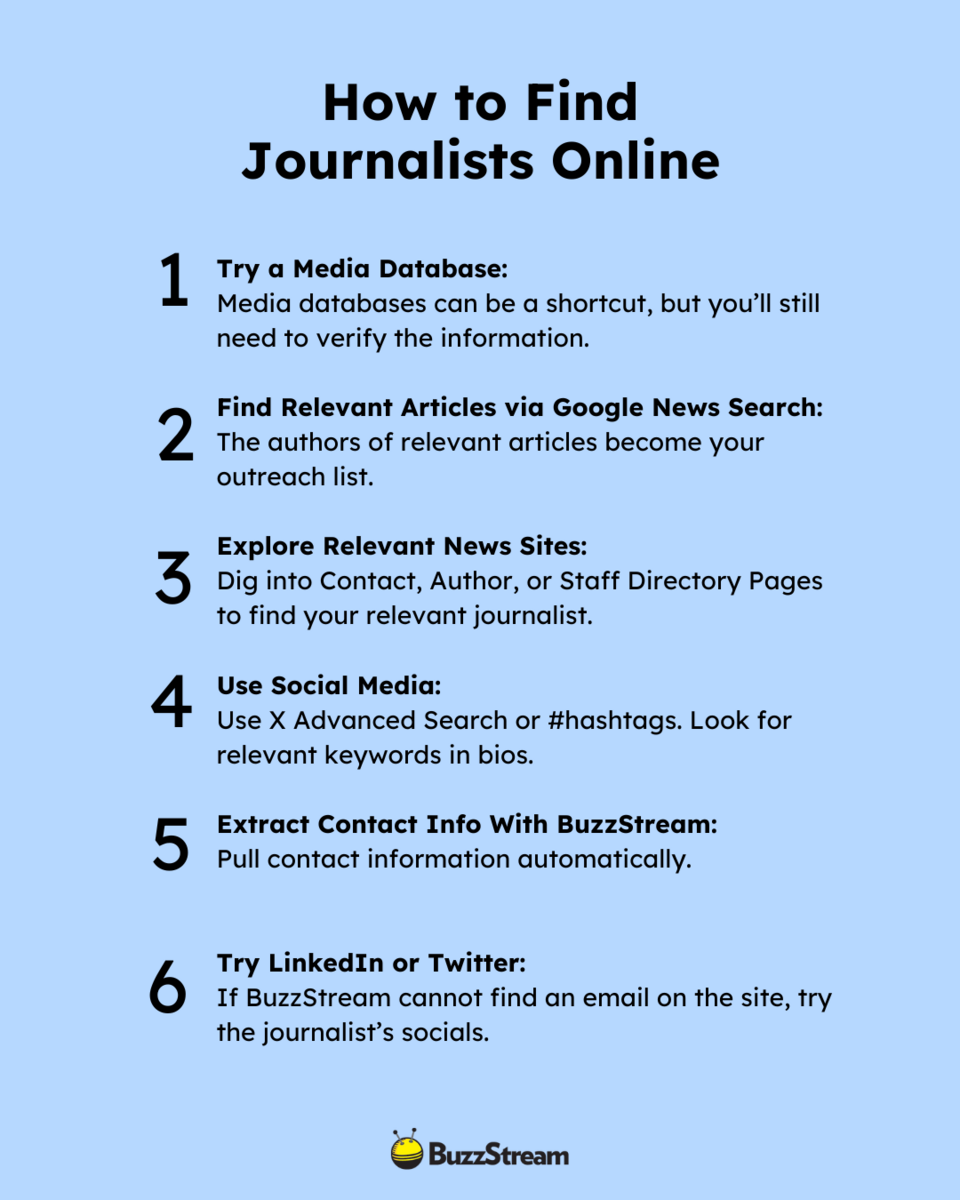
Build Relationships with Journalists
The best advice I can give anyone in their hunt to find journalists and connect with them to pitch a piece is to treat them like you would a friend or relative.
Journalists have jobs to do, but they are also real-life people on the other side of the email.
That is why I have never liked mass emailing people. Personalizing and targeting your emails to the right people is the way to go. (And these days, with Google’s anti-spam requirements, mass emails will land you right into the spam inbox anyway.)
By treating journalists with respect, you’ll find that you have a much easier time in your job.
Happy hunting.
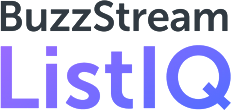
 End-to-end outreach workflow
End-to-end outreach workflow



 Check out the BuzzStream Podcast
Check out the BuzzStream Podcast







